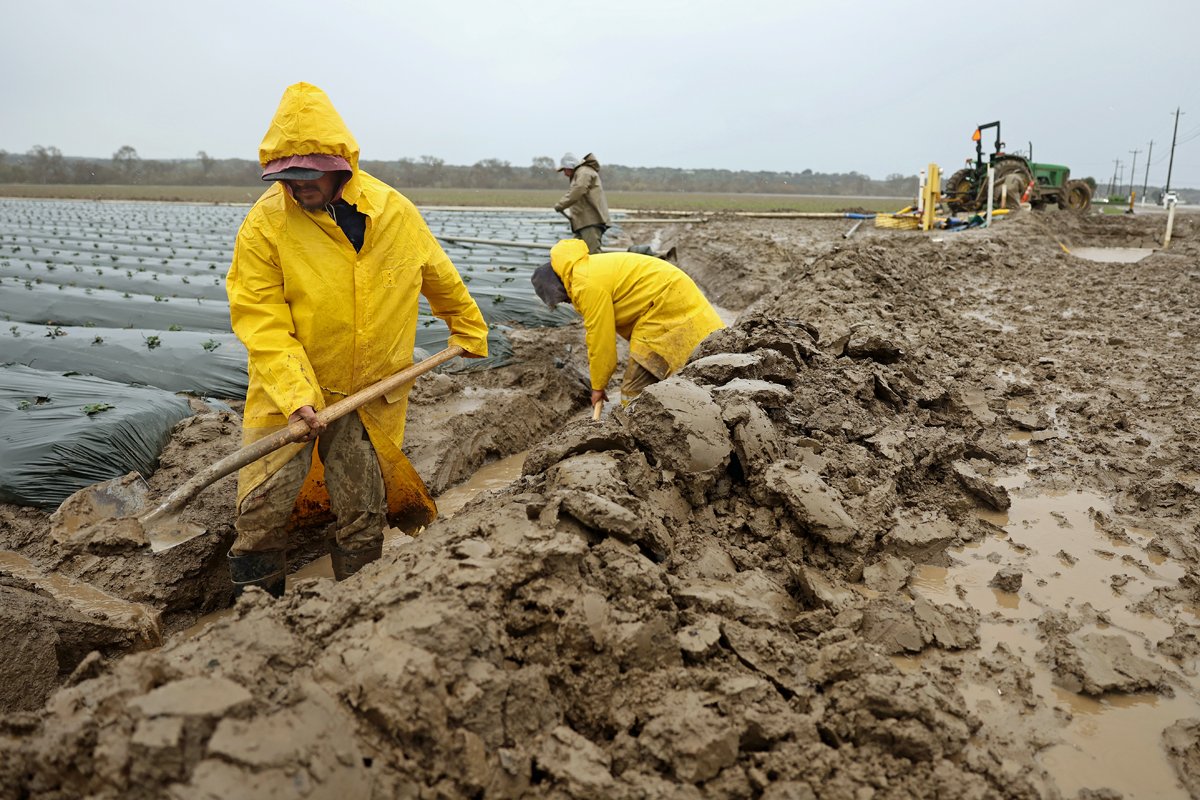Farmworkers who can’t work in flooded, damaged fields are losing out on weeks—or months—of wages.

Farmworkers who can’t work in flooded, damaged fields are losing out on weeks—or months—of wages.
March 29, 2023

Farmworkers dig an irrigation canal around a field of strawberries as the Salinas River begins to overflow its banks on January 13, 2023 in Salinas, California. Several atmospheric river events continue to pound California with record rainfall and high winds. (Photo by Justin Sullivan/Getty Images)
On a recent afternoon, Chepe Cervantes left work in the berry fields of Oxnard, California, early. Caked in mud, his boots and clothes soggy with floodwater, Cervantes had spent hours hunched over, salvaging strawberries from a flooded field, tossing the wet and moldy ones. He didn’t want to leave early, but there simply wasn’t enough work to justify a full day, and his supervisor told him and the rest of the crew to head home at 2 p.m.
For Cervantes, this was a familiar scenario—and one that is all too common in an unusually wet winter for the state. As a result, many of California’s farmworkers are struggling to afford rent, groceries, and other necessities.
“People with children who hire a babysitter to watch their kids, they don’t come out ahead only working until two,” Cervantes says through an interpreter.
“The entire month of January we didn’t work. Nobody had any income. I didn’t have any sales.”
Since early January, 11 storms fueled by atmospheric rivers have pounded California, resulting in devastating flooding that has wiped out farmworker communities in the central part of the state. On March 11, the Pajaro River busted through a levee and forced thousands in the farmworker community of Pajaro to evacuate. Many remain in shelters. Then, less than a week later, a levee broke near Allensworth, the first African American farming community in the state, causing more flooding in the basin of the former Tulare Lake.
Rain, wind, and flooding have been widespread across the state that produces a third of the country’s vegetables and two-thirds of its fruit and nuts. Strawberries, greens, and other specialty crops have taken a hit. In the coastal farmland of Monterey County, January storms damaged 15,700 acres of berries, wine grapes, celery, carrots, garlic, and other produce, resulting in a projected loss of $324 million.
Doroteo took this video in Lodi CA where he and his co-workers were trudging through a river of rainwater to prune wine grapesvines. He says: 2023 is the year that it rained too much. #WeFeedYou pic.twitter.com/mSAdYhZn4j
— United Farm Workers (@UFWupdates) March 27, 2023
Javier Zamora, owner of JSM Organics in northern Monterey County, says he lost the crops on 7 of his 27 acres when water blanketed his strawberry fields in January, and the severe weather made it impossible to harvest broccolini, leeks, and other winter vegetables that would’ve secured some income.
“The entire month of January we didn’t work. Nobody had any income. I didn’t have any sales,” he says, adding that come spring and summer those 7 acres of strawberries would’ve brought in up to $300,000 in revenue. “That’s big money for a small-scale farmer like me,” says Zamora. About two months ago, the farmer set up a GoFundMe page calling for donations to help pay his workers who were without wages. “Help me feed them so they can feed us!!” the page reads.
Antonio De Loera-Brust, a communications director with United Farm Workers (UFW), estimates that farmworkers living in flooded areas have lost up to two full months of wages. “This is a real economic catastrophe for workers. Farmworkers in general are already barely making ends meet,” says De Loera-Brust. “They’re living right at the poverty line, living paycheck to paycheck, so losing even a week or two of work is a real financial hardship. Losing a month of work is just devastating.”

Chepe Cervantes in drier times as he picks raspberries in Oxnard, California. (Photo courtesy of Chepe Cervantes)
According to the most recent National Agricultural Workers Survey, California farmworkers earn an average of just over $12 an hour. And De Loera-Brust estimates about half of farmworkers are undocumented and therefore unable to take advantage of unemployment benefits.
Cervantes, a 43-year-old father of four who is originally from Oaxaca, Mexico, says he and his fellow farmworkers hope that, “God willing, it will stop raining.” But even if sunshine returns, flooding risk lingers.
In a late-February online presentation, Daniel Swain, a climate scientist for UCLA and the Nature Conservancy, called the snowpack in the Sierra Nevada mountains “epic” and said parts of the state could wind up matching record high snowpack that was seen in the winter of 1982-1983.
That’s great news for drought relief and California’s meager water supply, Swain said, but if April or May bring heavy warm rains or heat waves, that “could cause major flooding this year because there is so much more snow stored up there than usual.”
Even when the weather is mild, most California farmworkers experience some periods of unemployment in the winter. According to the National Agricultural Workers Survey, almost 70 percent of surveyed workers reported not working in fields for an average of nine weeks, which often occur around the holidays, says De Loera-Brust, adding that farmworkers typically rely on savings during these slow periods.
The rain, however, has stretched over so many months, and pummeled so many critical farming regions, that it is disrupting important work that typically happens in the spring, such as pruning orchards and vineyards, and picking the first crop of strawberries. “Think of it as if you’ve been holding your breath underwater already,” says De Loera-Brust. “And now you can’t come up for air.”
“These guys have guts to work … Instead of finding celery we are finding fish!”
An aerial video of March flooding in Monterey County, an agricultural powerhouse with more than 1,100 farms, shows the Salinas River with swollen banks, and water the color of chocolate milk smothering thousands of acres of farmland.
Norm Groot, executive director of the Monterey County Farm Bureau, says with water still standing, it’s too early to know how much damage the most recent round of flooding has left behind, though in an email he said about 10 percent of the county’s acreage has been impacted.
Left: Farmer Donny Silva trying to remove branches and keep the Tule River from overflowing onto the bridge at Road 192 near Plainview. Middle: The Tule River washes a hole into the levee protecting orchards. Right: Heavy equipment is removing a tree trunk from the Tule River, trying to save the bridge on Road 192. (Photos © David Bacon)
The damage will likely be costly, and recovery likely slow, says Michael Cahn, an irrigation and water resources advisor with the U.C. Cooperative Extension of Monterey and surrounding counties. He heard from one farmer whose irrigation pipes were swept away in floodwaters, despite being buried 4 to 6 feet below ground. Some land disturbed by flooding will have to be leveled, and when it comes to planting leafy greens, there will be a mandatory delay.
According to the Leafy Greens Marketing Agreement, a set of food safety rules prompted by a 2006 E. coli outbreak linked to contaminated spinach, growers must wait 30 days after a flooding event to test soil for pathogens from broken septic tanks or animal feces. Another option is to wait 60 days, and testing isn’t required.
Zamora, who already had crops in the ground before flooding, will have to test soil, but what he’s more worried about is how the wet weather has stunted the growth of his surviving strawberries. “[With] all the rain and all the cold nights, they have not developed,” he explains, estimating that clusters of red berries will emerge more than a month behind schedule.
All this, of course, means farmworkers have little financial stability. Depending on how hard-hit their region is, work is either nonexistent, delayed, or, at the least, messy and difficult.
Isabel sent us this video from where she was harvesting strawberries in Oxnard last week to show people how tough harvesting strawberries is- especially during rainy weather. #WeFeedYou pic.twitter.com/jFQ8LJyZw5
— United Farm Workers (@UFWupdates) March 28, 2023
The UFW social media channels are filled with photos and videos of workers returning to soaked fields. In one video, workers wade through ankle-deep water to tie vines in vineyards in Northern California. In Oxnard, workers wrapped in plastic rain gear pick celery in knee-deep water, whacking at roots with sharp knives. “These guys have guts to work,” the person capturing the video says in Spanish, adding: “Instead of finding celery we are finding fish!”
In the summer of 2018, researchers from the Western Center for Agricultural Healthy and Safety at U.C. Davis interviewed 70 farmworkers about the perils of working in weather extremes, including scorching heat and floods. Farmworkers described the danger of slipping with sharp tools in the rain, as well difficulty operating equipment.
De Loera-Brust says for some workers there’s an “economic desperation” that sends them back into the fields. And he’s concerned that it could result in “people taking more dangerous jobs or being less willing to speak out if being put at risk.”
Farmworkers face a challenging future as the planet warms. A 2018 paper by a team of University of California researchers led by Tapan Pathak of U.C. Merced indicated that the state’s somewhat predictable pattern of wet and dry years will topple in the face of the climate crisis. Precipitation patterns will change, setting the stage for more drought and more flooding.
“[California’s] entire wet season is expected to shrink under climate change,” he says. “So even if we get the same amount of rain, that amount of rain might be happening under a shorter duration.”
In California, specialty crops like fruit and vegetables require human labor, and Pathak says it’s farmworkers who will disproportionately feel the impact of weather extremes, including extreme heat, flooding, and exposure to wildfire smoke hanging over agricultural fields. “They are the most under-resourced community. And when it comes to climate change, they are the most vulnerable community as well,” says Pathak.
For now, as fields slowly drain, and flooded communities start to clean up, both the UFW and local leaders are calling on state and federal agencies to assist undocumented workers who are not eligible for unemployment or other disaster relief.
Cervantes, who feels fortunate that farmworker homes in Oxnard were spared any major flooding, is hoping his work weeks will return to normal soon. He’s proud of his job as a farmworker, he says, but this winter has made him feel wary, even a bit on edge. After seeing entire farmworker communities destroyed and fields choked with water, he’s unsure what the next few months will bring, let alone the months and years that will follow.

September 4, 2024
By paying top dollar for milk and sourcing within 15 miles of its creamery, Jasper Hill supports an entire community.
September 3, 2024

August 27, 2024

August 26, 2024

Like the story?
Join the conversation.